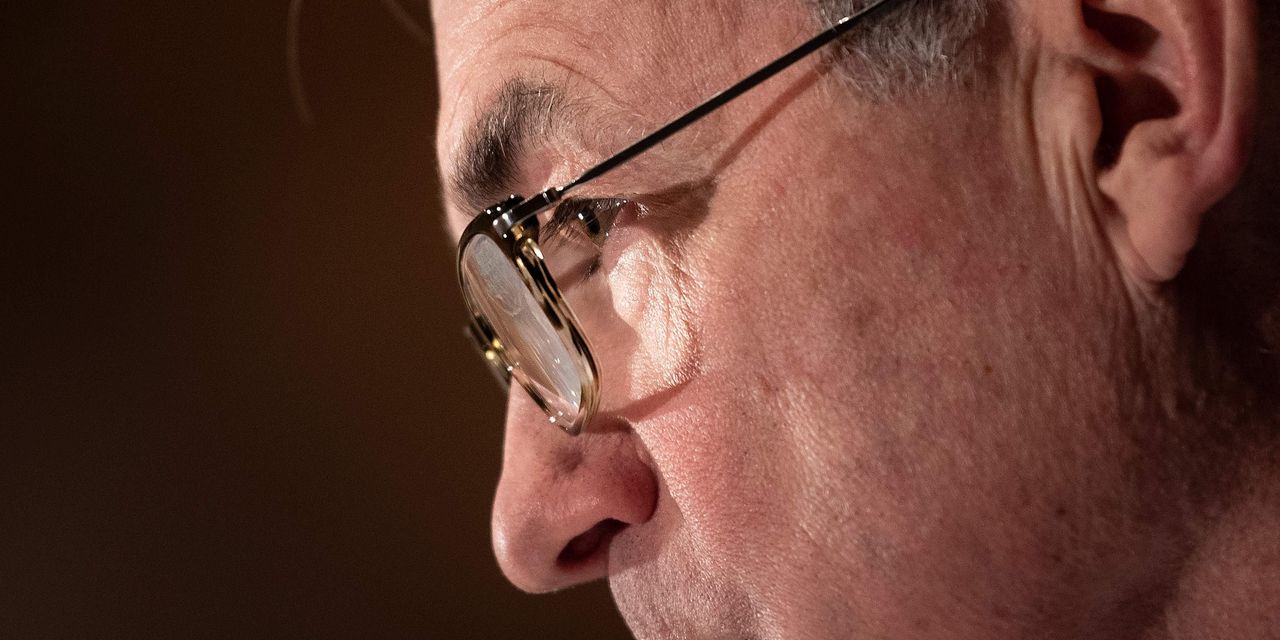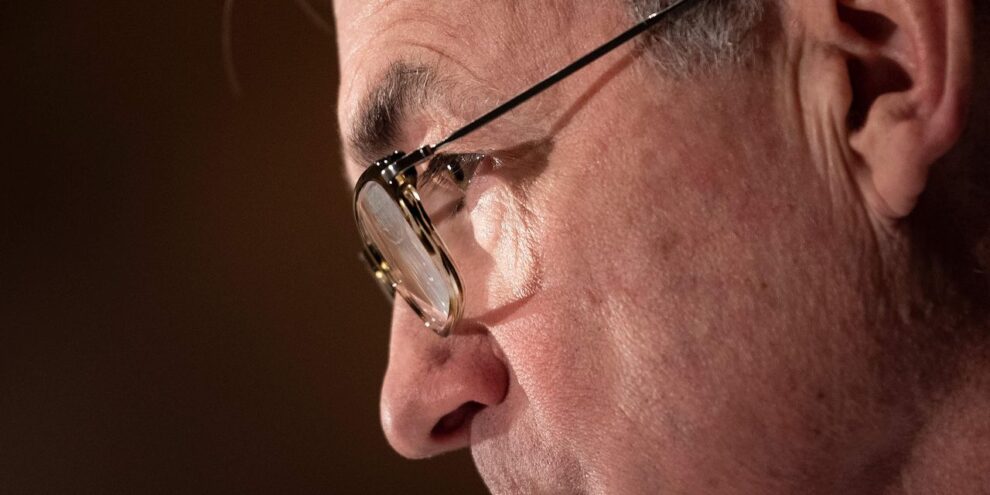
Stock benchmarks on Thursday fell for a third day, led by technology stocks, as Federal Reserve Chairman Jerome Powell said he was monitoring the recent rise in bond yields but added that the rise in inflation expected this year was unlikely to last and current monetary policy remained appropriate.
His remarks failed to soothe jittery bond markets, with the 10-year Treasury yield rising back above 1.50%.
How are stock benchmarks performing?
- The Dow Jones Industrial Average DJIA, -1.11% ended 345.95 points, or 1.1%, lower at a one-month nadir of 30,924.14, but up from an intraday low of 30,547.53.
- The S&P 500 index SPX, -1.34% fell 51.25 points, or 1.3%, to 3,768.47.
- The Nasdaq Composite COMP, -2.11% slid 274.28 points, or 2.1%, to reach 12,723.47, its lowest in three months. The tech-heavy index came to the brink of recording a 10% loss from its Feb. 12 peak, which would meet the commonly used definition for a correction.
On Wednesday, the Dow fell 121.43 points, or 0.4%, to close at 31,270.09, the S&P 500 shed 50.57 points, 1.3%, ending at 3,819.72, while the Nasdaq Composite Index slid 361.04 points, or 2.7%, to mark its largest two day percentage decline since Tuesday, September 8, 2020.
What’s driving the market?
At The Wall Street Journal Jobs Summit, Powell said he would be concerned about a disorderly move in the bond market, but suggested that it had yet to have a material impact on financial conditions. This comes after previous remarks by Fed officials that they were not overly concerned about the move up in bond yields.
“Chairman Powell’s unwillingness to commit along the lines of yield-curve control or drawing a more aggressive line in the sand is giving a moment of reflection for markets. There is a limit for what the Fed can and is willing to do and markets are now digesting that,” Yung-Yu Ma, chief investment strategist at BMO Wealth Management, told MarketWatch.
Powell’s remarks did not help markets though as investors fretted that if Powell shrugged off the recent rise in bond yields, it could spur further selling in a vulnerable Treasurys market and, in turn, weigh on equities.
“The real question is how far is the Fed going to let the long-end of the yield curve go. How steep does the curve have to be for them to start worrying,” said Kathryn Kaminski, chief research strategist at AlphaSimplex, in an interview, referring to how the rise in long-term yields has lifted their spread against their shorter-term peers.
The 10-year U.S. Treasury note TMUBMUSD10Y, 1.539% climbed to 1.55%, up around 8 basis points from where it traded at the end of Wednesday and the highest levels in about a year.
Powell’s comments mark the last from Fed officials before a self-imposed “blackout” period ahead of the next two-day policy meeting starting on March 16.
Some of the volatility on Thursday also reflected a “great rotation” as some analysts describe a shift out of highflying technology stocks, viewed as expensive by some measures, to other areas of the market considered undervalued, including energy and financials.
Analysts say the move reflects how investors are pricing in economic recovery and better times for stocks hit in the past year by the COVID-19 pandemic, reversing some of the gains from technology stocks that thrived under business lockdowns and social-distancing protocols last year.
See: Stock market crash? No, but a rotation away from U.S. tech stocks is shaking up some investors
Stocks had initially traded relatively strongly after initial jobless claims in for the week ended Feb. 27 rose 9,000 to 745,000 which was a smaller rise than the 750,000-760,000 estimates expected by economists surveyed by Econoday and Dow Jones. And new federal jobless claims totaled 436,696 in the week.
Read: U.S. likely added 210,000 jobs in February — and hiring is ready to speed up
Beyond the weekly jobless claims data, a reading of productivity and costs showed that U.S. productivity tapered off less than previously estimated at end of 2020.
Separately, U.S. factory orders rose 2.6% in January as manufacturers continued to lead the way for the U.S. economic recovery. Orders for durable goods made to last at least three years climbed an unrevised 3.4% last month. Orders for nondurable goods such as clothing and groceries rose a slower 1.9%.
Which stocks are in focus?
- Flipkart, the online Indian retailer mostly owned by Walmart WMT, -0.05% is considering a U.S. listing by merging with a special-purpose acquisition company, Bloomberg News reported, citing people familiar with the matter. Shares of Walmart were down 0.1%.
- BJ’s Wholesale Club Holdings Inc. BJ, -1.09% reported Thursday fiscal fourth-quarter profit, revenue and same-store sales that topped expectations as the COVID-19 pandemic provided a boost, while not providing a financial outlook given uncertainties related to the pandemic. The company’s stock was off 1.1%.
- Discount retailer Burlington Stores Inc. BURL, +11.19% said Thursday it had net income of $155.9 million, or $2.33 a share, in the fourth quarter, down from $206.3 million, or $3.08 a share, in the year-earlier period. Burlington shares gained over 11%.
- Ciena Corp. CIEN, -3.34% reported Thursday fiscal first-quarter profit and revenue that beat expectations, with networking revenue falling less than forecast, while the company didn’t provide financial guidance. Its shares fell 3.3%.
- Kate Spade, part of the Tapestry Inc. TPR, -1.92%, said Thursday that Nicola Glass, the brand’s creative director, has stepped down from that role, effective April 1. Tapestry shares slid 2.1%.
How are other assets faring?
- The dollar jumped 0.8%, as measured by the ICE U.S. Dollar Index DXY.
- Oil futures rose after the Organization of the Petroleum Exporting Countries said it will roll over current production cuts through April, sending the U.S. benchmark CL.1 gained $2.55, or 4.2%, to settle at $63.83 a barrel.
- Gold futures GC00 lost $15.10, or 0.9%, to settle at $1,700.70 an ounce.
- Equities edged lower in Europe, with the pan-European Stoxx 600 index SXXP and London’s FTSE 100 UKX both closing down 0.4%.
- Stocks pulled back in Asia: the Shanghai Composite SHCOMP shed 2%, giving up the previous session’s gains, Hong Kong’s Hang Seng Index HSI lost 2.2%, and China’s CSI 300 000300 tumbled 3.2%, while Japan’s Nikkei 225 NIK shed 2.1%.






